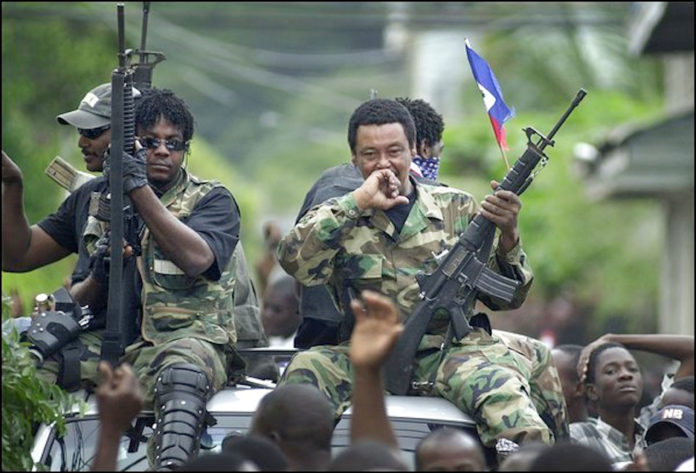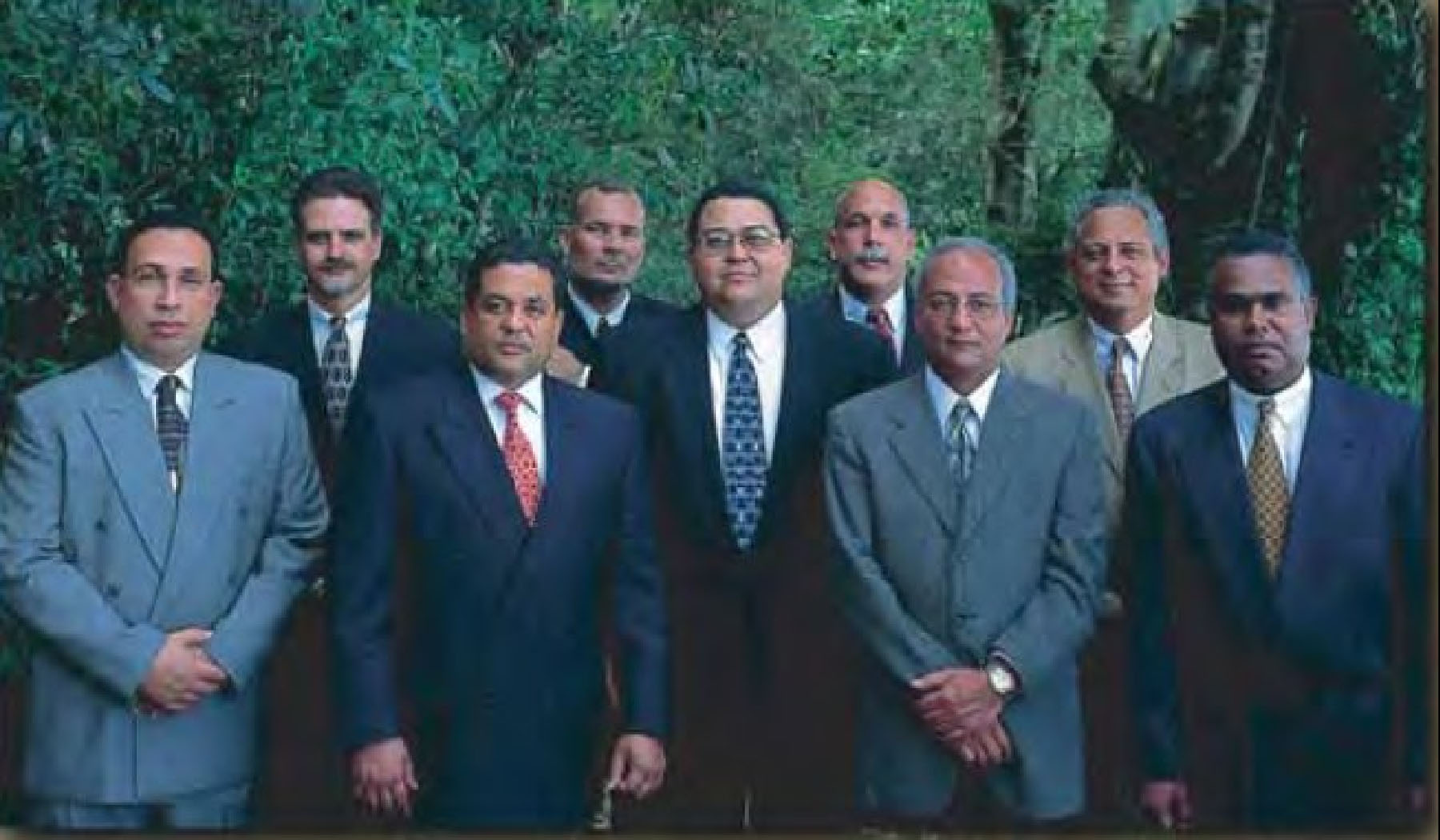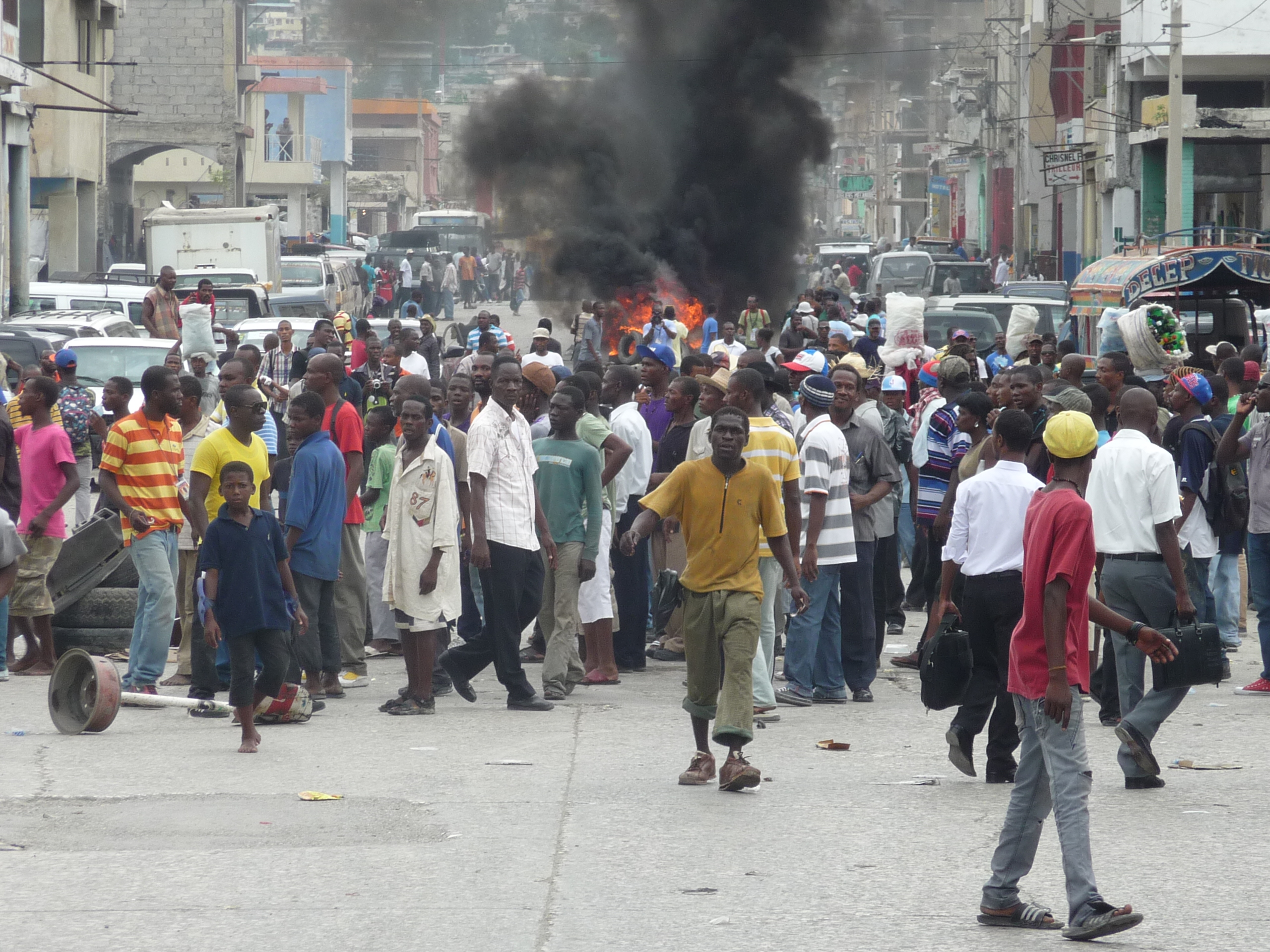
-
The FLRN (2000–2005) and beyond
Paramilitarism’s fourth phase occurred through the development of the FLRN (2000– 2005). The driving underground of the FRAPH and the demobilization of Haiti’s army in 1995 created a new historic condition in which a secretly reconstructed paramilitary force would eventually constitute the only viable coercive strategy for rightist elites to deploy. It would be used to re-establish their political monopoly and halt justice processes targeting their impunity.
Paramilitary groups (a major one of them being the FLRN) became the new modus operandi for reinstating the anti-democratic order. This new contingency, though, took time to constitute as, unable to depend on Haiti’s state apparatus (local paramilitaries’ traditional patron), it required covert sponsorship from a network of powerful interests. These new paramilitary “rebels” took shape in late 2000, as a group of the new police/ former-FAd’H chiefs initiated a paramilitary war of attrition on Haiti’s constitutional government. These police chiefs appear to have been upset at several things – the continued drive to alter the Constitution to permanently disband the armed forces, continued judicial processes to hold ex-FAd’H and paramilitaries accountable for their crimes, as well as mounting competition they faced in the narco-trade from other security officials with better government contacts. They benefitted most from their connections with sectors of the extreme right and Duvalierist elite advocating for regime change, and from their connections within the Dominican foreign ministry and military. Articulating this project of domination, one mid-level industrialist (and extreme rightist) living in Miami explained: “Without the army, it was up to us. I supported any and all ways to bring down the dictatorship [referring to the country’s democratically elected Lavalas government].”
Evidence also suggests that the paramilitaries received intermittent support from some French and U.S. intelligence agencies. Using the Dominican Republic as a base, this new paramilitary force was able to ramp up their murderous operations. The FLRN’s violent campaign between 2001 and 2004, its raids brutalizing rural and urban communities, went largely unreported in the international and local media. By late 2003, former FRAPH leader Louis-Jodel Chamblain had reemerged, as a leader of the FLRN. This occurred in the lead-up to the Feb. 29, 2004 coup (in which the Bush regime removed the country’s elected President, Jean-Bertrand Aristide, who was then serving his second, though non-consecutive, term). The prevailing correlation of forces in Haiti, an aid-dependent and underdeveloped country, made it extremely difficult for the resource-starved Lavalas government to stand, when arrayed against it were forces of such power and wealth.
Haiti’s hobbled democratic project had made some progress in its campaign for heightened social investment and challenging the impunity of army and paramilitary thugs and their elite financiers (a number of whom were put on trial and jailed). While facing many of its own internal contradictions, the Lavalas project was ultimately worn down through economic and political destabilization, a paramilitary campaign, and the direct U.S. intervention.

In the wake of the coup, U.S. embassy officials and other transnationally-oriented elites facilitated the formation of an interim government (with a former World Bank official heading it up). In fact, U.S. officials had to work to maintain the local far-right sectors’ support for the new post-coup regime, as some of them complained of not receiving positions and being left behind in the political transition.
Human rights investigators soon found that under the unelected post-coup regime (2004–2006), paramilitary groups, operating alongside the post-coup police force, were used to launch constant raids into Port-au-Prince’s popular neighborhoods. This resulted in thousands of dead and wounded. Discussing her family’s experience, Edwidge Danticat writes:
The year the United Nations Stabilization Mission in Haiti (MINUSTAH) came to the country was a deadly one for my family …. the Haitian national police and MINUSTAH soldiers conducted joint raids in Bel Air that led to dozens of mostly unreported injuries and deaths. The following month, UN soldiers and Haitian riot police climbed up to the roof of my uncle’s church and killed some of his neighbors below. My uncle was forced to flee to Miami, where he died in the custody of U.S. immigration officials after being denied asylum.
Throughout the months following the February 2004 coup, supporters of the ousted government held large protests, which were violently attacked by paramilitary snipers and the post-coup government’s security forces. This eventually led to a half dozen armed groups of (mostly) youths from the capital’s impoverished popular neighborhoods, beginning to fight the post-coup authorities, which included the UN mission (who responded with extremely brutal force).
It was during this “emergency period” that U.S., OAS and UN policymakers signed off on inserting criminal paramilitaries directly into the police force, bolstering its numbers. The idea that rebels “needed” to be held accountable for their crimes was of course unthinkable. Instead, a nuanced strategy was devised in which transnationally-oriented power brokers integrated some of the paramilitaries (at least 400 in total) into the police and state security apparatuses, while sidelining and providing impunity to the most well-known paramilitary leaders. It served the goal of re-institutionalizing the Haitian elite’s vehicle for class rule and in a manner acceptable to transnational elites, while avoiding having to deal with the most controversial death squad figures.
The new global ruling class is seeking out more sophisticated strategies to extend and maintain their power.
Human rights investigators documented how, in 2004 and 2005, UN forces launched brutal raids, and at times were shadowed by para-police units who would wear masks to cover their faces. As Pierre and Sprague observed: “buildings throughout Cité Soleil were pockmarked by bullets; many show huge holes made by heavy calibre UN weapons, as residents attest. Often pipes that brought in water to the slum community now lay shattered.”
One declassified document from the U.S. embassy in Port-au-Prince revealed that during an operation carried out in July 2005, MINUSTAH (the United Nations Stabilisation Mission in Haiti) expended 22,000 bullets over several hours. In the report, an official from MINUSTAH acknowledged “given the flimsy construction of homes in Cité Soleil and the large quantity of ammunition expended, it is likely that rounds penetrated many buildings, striking unintended targets.”
Media reports and protests over these raids became embarrassing for UN officials. By early 2006, local elites were demanding that the UN and interim government intensify their attacks on unruly slums. Some believed these mounting pressures were a reason behind the supposed suicide of MINUSTAH’s force commander Lt. Gen. Urano Teixeira Da Matta Bacellar. (Dominican had intelligence that it was an assassination – HL.) The violent repression of rebellious urban populations is a double-edged sword, seen as an urgent necessity by some ruling groups but also difficult to manage for transnationally-oriented elites.
Meanwhile, once the MINUSTAH troops and the local post-coup forces had gained relative control over Port-au-Prince’s slums (and the paramilitaries were no longer required, a significant portion having been inserted into the police), the interim government and its transnational backers offered sectors of the most hardline paramilitaries inducements to disband.
Paramilitary commander Rémissainthe Ravix refused, as he planned for his forces to remain mobilized. Ravix demanded the immediate remobilization of the ex-army. This proved embarrassing and threatening to the plans of transnationally-oriented policymakers, so the crisis was dealt with swiftly. In early April 2005, UN troops killed Ravix and some of his followers in a shootout. This epitomized the reining in of the most extreme paramilitary elements.
In the years after the coup and the 2010 earthquake, Haiti’s right-wing forces have slowly reconstituted themselves as a political force in the country, undertaking slick marketing as well as “giveaway” and mass voter-suppression strategies to achieve this.
Under the right-wing governments of Michel Martelly (2010–2016) and his ally Jovenel Moïse (2017–) – both having come to office through historically low election turnouts – efforts are being made to rebuild the once disbanded army. Neo-Duvalierist groups, allied with Martelly and Moïse, and involved in operating private security training camps, pushed for and won the army’s formal return last year. OAS’ Inter-American Defense Board are hoping the “new army” will be a less-embarrassing coercive apparatus.
Conclusion
Paramilitarism in Haiti has traditionally been spawned by sectors in the Haitian ruling class with U.S. imperial support. But the country’s traditional ruling classes are transforming as they are subordinated to transnational capital. The new global ruling class (the transnational capitalist class or TCC) and its allied strata (most importantly, those within the U.S. state apparatus) are seeking out more sophisticated strategies to extend and maintain their power. Under this situation, some forms of paramilitarism have been more effective as complements to capitalist accumulation then others. We might argue that there is a certain learning curve or evolution in the effectiveness of local elites to employ coercive forces to supplement their economic and political interests.

There have been different phases and forms of Haiti’s paramilitary apparatus, impacted by the local class conflict as well as by new transnationally-oriented elite groups (including those operating through the U.S. state apparatus). Such elites’ agenda has been to stabilize the country as a secure platform through which global capital can flow – where the poor can improve the profitability of transnational corporations or TNCs.
This has also meant, at times, taking advantage of or softening attempts by antiquated ultra-right groups seeking to re-institutionalize aspects of the “old order.” With large-parts of Haiti’s population facing a desperate situation, we can see how new rounds of hyper-neoliberal “shock doctrine” were enacted immediately after the coup and earthquake to strengthen transnational capital. Major components of Haiti’s post-earthquake development strategy have centered on drawing in global investors, a practice seen in the U.S. and World Bank facilitation of assembly factory free-trade zones, a new deep-water port, planned new mining developments, and a host of rearranged laws. This economic restructuring’s political corollary has been a UN military occupation and a remaking of Haiti’s political scene, alongside a deepening exclusion of the poor.
An unavoidable problem is that transnational capital does not require the social reproduction of a large part of the planet’s population, “superfluous” human beings not required by global capitalism. This means that a significant portion of the world’s population, like many in Haiti, are structurally marginalized. With each political transition in Haiti since the Duvalier dynasty’s fall, we see transnational elites’ attempts to manage the problems associated with the military and paramilitary Frankenstein which they have sometimes required to repress the country’s marginalized masses. Ex-army and paramilitary groups (and their local elite backers) have thus been able to maintain their impunity, while they have had to rebrand and remake themselves.
Revamped strategies have been used to consolidate power in the hands, this time, of a transnational bourgeoisie. However, with much of Haiti’s population marginalized, Haiti’s popular social and political movements continue to mobilize against their exclusion. In addition, workers in the country’s new assembly factories have launched protests over their terrible exploitation and conditions. In November 2017, school kids marched in the hundreds in Cap-Haïtien declaring: “We don’t want an army; it’s education we want” (in Haitian Kreyòl: “nou pa vle lamè, edikasyon nou vle”).
This has created difficulties for leading dominant groups and their strategies. Under these conditions, as the structural reality sets in, it is only a matter of time until certain elite groups or state actors are again mobilizing paramilitaries.
The working class and poor are more and more entwined with transnational circuits of accumulation in their labor and consumption and are thus becoming functionally integrated across borders through their productive relations, remittance networks, global communications, and other dynamics. Social forces in the region, while conditioned in many ways by local particularities, are entering a qualitatively new era of transnational integration and inequality. Working and popular classes in the Caribbean and worldwide must move toward new forms of solidarity and organizing, not only within nations but also functionally across borders – seeing how our struggles for justice and equality are interlinked. Even when surrounded by very difficult conditions, we must not forget that human society and its future is what we make of it.
(This article was adapted from Sprague-Silgado’s longer, foot-noted article earlier this year in the British scholarly journal, Third World Quarterly.)









